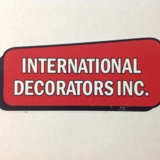Information
-
Project Name & Divisions
-
Project Name & G.C.
-
Location
-
Conducted on
-
Prepared by
-
Personnel
-
I.D.I. Superintendent(s)
Personal Protective Equipment. (PPE)
-
Hard hats / head protection worn by all employees<br>
-
Eye protection worn when required
-
Face shield being used when required
-
Gloves / hand protection being used when required
-
Hearing protection being used when required
-
Appropriate respirator being used when required
-
Work boots worn by all employees (no gym shoes, sandals, bare feet)
Electrical
-
Extension cords in safe condition for use (no cuts in outer insulation, no exposed wires, no missing ground prong)
-
Electrical cords compliant with our assured grounding program
-
GFCI being used if required by conditions or project requirement
-
Electrical panels appropriately covered or our employees protected from coming within 6' of a live exposed panel
-
10' minimum clearance from live high voltage power lines
-
Temporary lights in our work areas guarded
-
Halogen light bulb guards in place
-
Proper use of temporary power boxes
-
Lock out / tag out procedures in place and being implemented if required
-
Are all energized electrical components protected to reduce employee exposures
Housekeeping and Other
-
Clear access to building, structure & work location
-
Are slip, trip & fall hazards in reasonable condition to minimize risk of injury
-
Impalement protection
-
Proper material storage
-
Fire extinguishers present and charged
-
Adequate lighting
Mobile Baker Type Scaffolds
-
Scaffolds in safe condition for use
-
Being used in a safe appropriate manner within our company policies
Mini-Perry Mobile Workstands
-
In safe condition for use
-
No one working above 3rd rung level
-
Being used in a safe manner and within our company's policies
Pipe or Frame scaffolding
-
Is the scaffold set up in the correct manner and safe for employees to work on
-
Scaffold fully planked at working level
-
Guardrails in place when required (10' per OSHA or must follow G.C. rule if more stringent
-
Scaffold being used in a safe appropriate manner and within our company's scaffold policies
Fall Protection (6' fall hazard exposures)
-
Guardrails or barricades in place protecting our employees from falls of 6' or more to lower levels
-
Do guardrails meet OSHA requirements
-
Floor holes adequately covered within OSHA requirements (secured, demarcated, capable of supporting 2 x load)
-
If using fall arrest or restraint equipment, was it inspected and in safe condition for use
-
Proper 5,000 lb anchorage point
-
Roof edge or sharp edges protected from cutting our lifelines, lanyards, etc.
-
Is all fall arrest and/or restraint equipment being used in the correct appropriate manner
-
Is the employee's free fall distance limited to 6' or less
-
Are all employees protected from fall exposures of 6' or more to lower levels
-
If using metal pan roof anchors, are all baseplate holes filled in with 1 1/4" # 12 tek screws and using a retractable lanyard
Aerial Lifts
-
Aerial lifts in safe condition for use
-
Floor surface free of pits, holes & depressions which could cause tipping
-
Safety gate or chain closed
-
Feet on platform floor (no climbing or standing on safety rails)
-
Lift being used within rated weight capacity
-
10' clearance from power lines
-
If using boom lift, safety harness worn by employees and are they tied off to manbasket's anchorage point
-
Overall, are aerial lifts being used in a safe appropriate manner and within our company's policies
Ladder Safety
-
Are ladders in safe condition for use
-
Extension ladders being used to access higher levels extended 3' and secured
-
No standing on top 3 rungs of straight ladders & top 2 steps of portable A-frame ladders
-
Are portable A-frame ladders being used in the fully open position with the spreader arms locked
-
No one using make-shift ladders such as 5-gallon buckets to stand and work on
-
Ladders or stairs with handrails being used when access area has a > 19" break in elevation
-
Are ladders being used safely, appropriately and for their intended use
Stairs
-
Are stair treads filled in
-
Do stairs have handrails
-
Do stairways have adequate lighting
-
Are the stairs clear of debris, materials & equipment
Stilt Safety
-
Are stilts in safe condition for use
-
Floor conditions safe for stilt usage
-
Stilts being used in a safe manner
-
No stilt usage on computer floors
Tool safety
-
Are tools and cords in safe condition for use
-
Blade guard or machine guard in place and working appropriately
-
Ground prongs in place on tools and equipment that require them
Back Injury or Lifting Related Hazards
-
Are employees using safe lifting procedures
Hazard Communication
-
Are M.S.D.S. readily available
Medical
-
1st aid kit accessible to employees
-
Occupational health clinic & emergency medical center established
Other Employee Safety Issues
-
Any other employee safety issues that are not noted above (unsafe acts, unsafe behavior, violating co. rules, Etc.)
Other Job Site Safety Issues
-
Any other job site safety issues that are not noted above
-
Safety Inspection Completed by Peter Graham, Safety Director for International Decorators, Inc.






